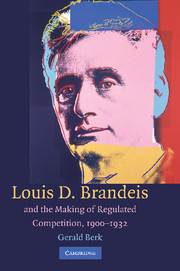Book contents
- Frontmatter
- Contents
- Figures and Tables
- Acknowledgments
- 1 Creative Syncretism
- PART I BRANDEIS AND THE THEORY OF REGULATED COMPETITION
- PART II REGULATED COMPETITION IN PRACTICE
- PART III REGULATED COMPETITION CONTESTED
- 8 The Politics of Accountability
- PART IV CONCLUSION
- Appendix Industries and Number of Associations with at Least Substantial Involvement in Developmental Association, by Industry Group
- Index
8 - The Politics of Accountability
Published online by Cambridge University Press: 23 November 2009
- Frontmatter
- Contents
- Figures and Tables
- Acknowledgments
- 1 Creative Syncretism
- PART I BRANDEIS AND THE THEORY OF REGULATED COMPETITION
- PART II REGULATED COMPETITION IN PRACTICE
- PART III REGULATED COMPETITION CONTESTED
- 8 The Politics of Accountability
- PART IV CONCLUSION
- Appendix Industries and Number of Associations with at Least Substantial Involvement in Developmental Association, by Industry Group
- Index
Summary
Conflict over the meaning of antitrust reemerged in the 1920s, when the Department of Justice and private litigants challenged the legality of trade practice conferences and developmental associations in court. These cases pit two methods of assessing accountability against each other. On one side were the critics of regulated competition: the Department of Justice, the courts, and the economists. Like the progressive economists and laissez-faire constitutionalists we encountered in Chapter 2, they wanted to subject regulated competition to standards of classification. They asked whether trade practice conference rules and trade association instruments were instances of perfect competition or artificial monopoly, which served public or private interests. Adopting deductive categories from economics, they hoped to establish a bright line between private rights and public authority and then measure trade practice rules and trade association instruments against that classification. On the other side were the partisans of regulated competition: Brandeis (now an associate justice on the Supreme Court), the FTC, trade associations, and the cost accountants. They wanted to subject trade practice conferences and developmental associations to standards of process, power, and performance. Like Brandeis's social theory of restraints of trade (explained in Chapter 2) or Gaskill's theory of customary competition (explained in Chapter 4), they asked: What was the historical process that resulted in problems that trade practice rules or trade association instruments were intended to solve?
- Type
- Chapter
- Information
- Publisher: Cambridge University PressPrint publication year: 2009

